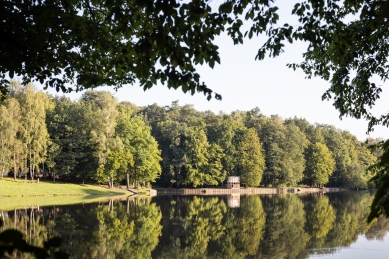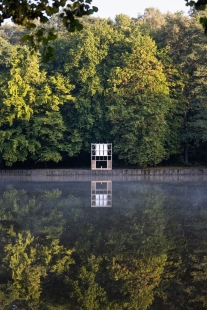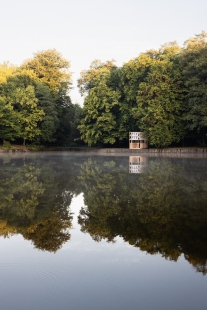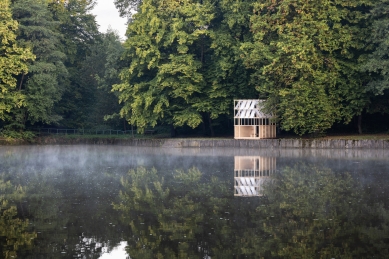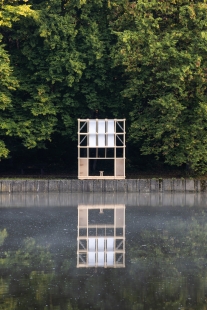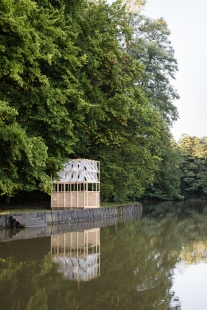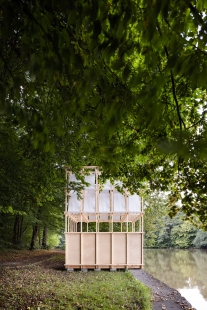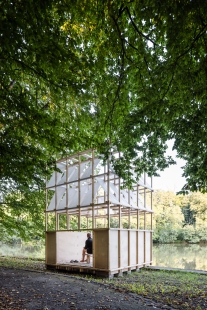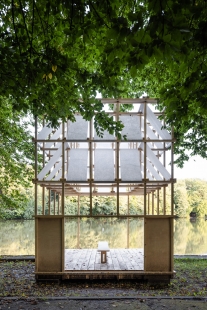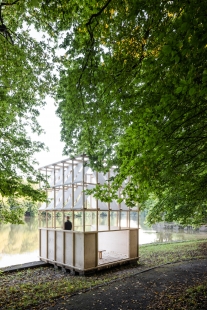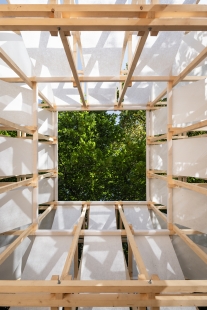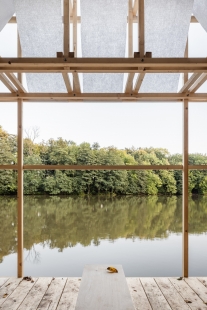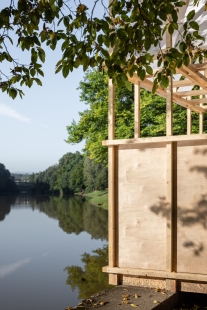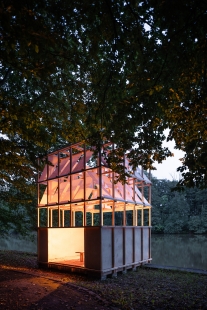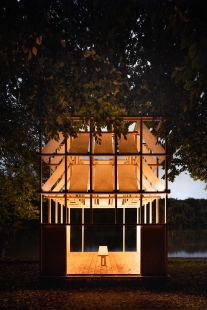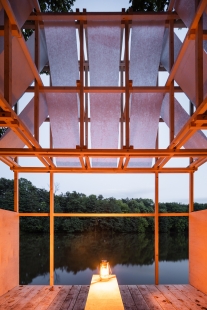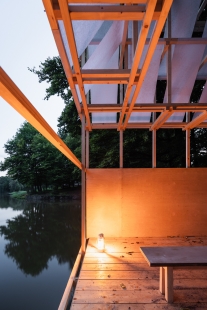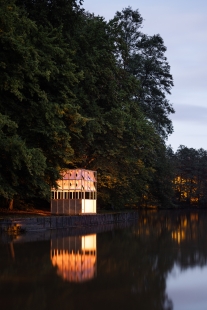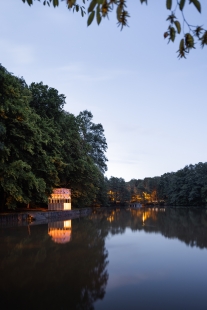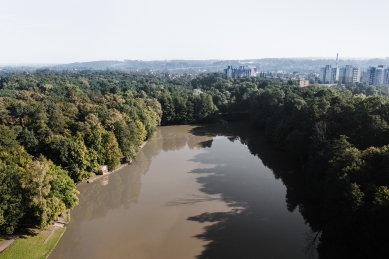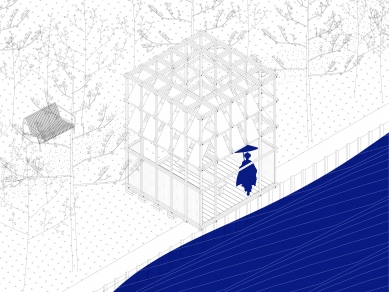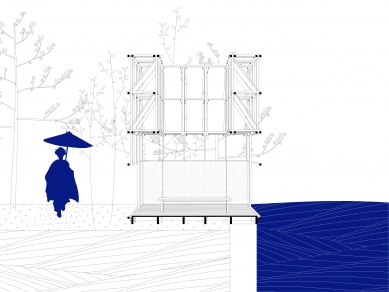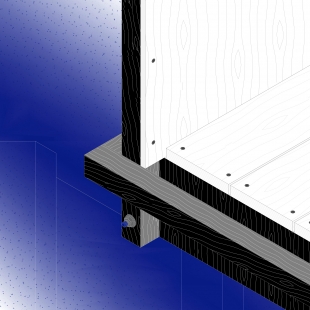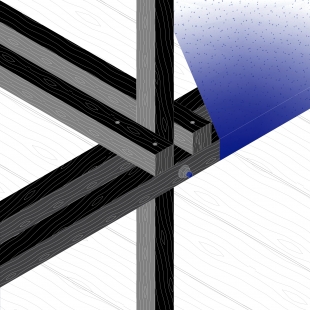
<Tea> <House> <Pavilion> </Tea> </House> </Pavilion>

The pavilion invites people to a close experience with nature, focusing visitors’ attention on the water reservoir – with its views, sounds, and movements. It compels one to stop and slow down thanks to the endless view into the treetops, the framed sight of the unlimited calm water surface, and the gentle closure from the surrounding hustle and bustle of everyday life. The interior of the pavilion comfortably accommodates 6 people, seated face-to-face around a table during the tea ceremony, creating a certain sense of intimacy for the ritual. The subtle/light, open construction refers to traditional Japanese interiors while introducing modern elements. It harmoniously and gently blends into the surrounding environment.
Several rules of traditional tea ceremonies were incorporated into the final design. Upon entering the interior, each visitor must bow to pass under the lowest horizontal beam of the structure, referencing the niriji – guchi doors, a symbol of equality among all participants in the ceremony. At the same time, upon entering, a view opens that directs attention to the water surface. The low table in the middle of the layout invites visitors to sit on their knees, as is customary in Japanese culture. The sheathing of the lower part of the structure with plywood boards provides a sense of privacy and detachment from the noise of the exterior. The open entry frame allows a glimpse into the interior, and passersby can see the ongoing tea ceremony. The height of the table gives it versatility for use both during the tea ceremony and outside of it as a bench offering a place to sit and peaceful contemplation, following the Japanese ideology focused on simplicity and aesthetic sophistication. The table becomes the only central piece of furniture in the pavilion, its depth allowing ceremony participants to sit in close proximity with a sense of connection. The pavilion has a multifunctional character and, in addition to the tea ceremony, can also serve as a pleasant summer pavilion with soothing views of nature. The square floor plan refers to simplicity, and the use of primary elements represents the symbol of matter and humanity.
The pavilion's structure is on a footprint measuring 3 x 3 m with a height of 4 m, which is also the structural height of the wooden spruce beams of square cross-section and the maximum permissible height of the pavilion. Raw wooden elements are complemented by a fine fabric that brings a sense of coziness while keeping the pavilion still minimalist, so as not to disrupt the ceremony itself, achieving a sense of peace and harmony. Other materials used include spruce floor slats, birch plywood, and roof geotextile. The mass of the pavilion derives from the shape of traditional tea pavilions. Diagonally secured fabric at two height levels along with the closure of two side walls with birch plywood create an impression of privacy and protection from the weather elements, sun, and rain that a home provides, while still allowing the frame structure to remain airy and open, enabling connections with the exterior and the emergence of unconventional views. The fabric at two levels brings a certain playfulness to the pavilion that aims to evoke traditional Japanese architecture.
Several rules of traditional tea ceremonies were incorporated into the final design. Upon entering the interior, each visitor must bow to pass under the lowest horizontal beam of the structure, referencing the niriji – guchi doors, a symbol of equality among all participants in the ceremony. At the same time, upon entering, a view opens that directs attention to the water surface. The low table in the middle of the layout invites visitors to sit on their knees, as is customary in Japanese culture. The sheathing of the lower part of the structure with plywood boards provides a sense of privacy and detachment from the noise of the exterior. The open entry frame allows a glimpse into the interior, and passersby can see the ongoing tea ceremony. The height of the table gives it versatility for use both during the tea ceremony and outside of it as a bench offering a place to sit and peaceful contemplation, following the Japanese ideology focused on simplicity and aesthetic sophistication. The table becomes the only central piece of furniture in the pavilion, its depth allowing ceremony participants to sit in close proximity with a sense of connection. The pavilion has a multifunctional character and, in addition to the tea ceremony, can also serve as a pleasant summer pavilion with soothing views of nature. The square floor plan refers to simplicity, and the use of primary elements represents the symbol of matter and humanity.
The pavilion's structure is on a footprint measuring 3 x 3 m with a height of 4 m, which is also the structural height of the wooden spruce beams of square cross-section and the maximum permissible height of the pavilion. Raw wooden elements are complemented by a fine fabric that brings a sense of coziness while keeping the pavilion still minimalist, so as not to disrupt the ceremony itself, achieving a sense of peace and harmony. Other materials used include spruce floor slats, birch plywood, and roof geotextile. The mass of the pavilion derives from the shape of traditional tea pavilions. Diagonally secured fabric at two height levels along with the closure of two side walls with birch plywood create an impression of privacy and protection from the weather elements, sun, and rain that a home provides, while still allowing the frame structure to remain airy and open, enabling connections with the exterior and the emergence of unconventional views. The fabric at two levels brings a certain playfulness to the pavilion that aims to evoke traditional Japanese architecture.
The English translation is powered by AI tool. Switch to Czech to view the original text source.
0 comments
add comment


